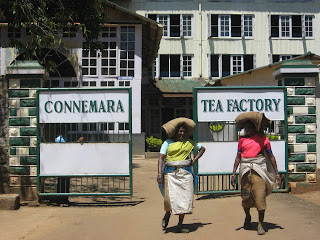In my last entry I did not give you any historical info on the amazing temples and sculpture at Hampi, so here it is (with the help of our travel Bible, the Lonely Planet).
Hampi was mentioned in the Ramayana as the realm of the monkey gods.Some of the temples still have packs of monkeys but in town the villagers aren't real sweet on the monkeys - one restaurant owner kept his slingshot handy and whenever a monkey would swing down from a nearby tree onto his roof, he'd aim and shoot.
In 1336 prince Harihararaya made his new capital in Hampi and called in Vijayanagar - it grew into one of the largest Hindu empires in Indian history. This is a picture of the elephant stables which are part of the queen's zenana (enclosure) . I guess they are still in excellent condition after so many centuries because the builders had to keep in mind the strength of the elephants!! You may not be able to tell, but each of those archways leads to an elephant sized chamber. Each dome over the chamber adds the additional height necessary for an elephant to comfortably stand.
In 1565 a group of sultans razed the thriving metropolis and it fell into disuse and disarray. Now it is visited by large numbers of tourists, but don't think that means it is easy to get to!!
Hampi was mentioned in the Ramayana as the realm of the monkey gods.Some of the temples still have packs of monkeys but in town the villagers aren't real sweet on the monkeys - one restaurant owner kept his slingshot handy and whenever a monkey would swing down from a nearby tree onto his roof, he'd aim and shoot.
In 1336 prince Harihararaya made his new capital in Hampi and called in Vijayanagar - it grew into one of the largest Hindu empires in Indian history. This is a picture of the elephant stables which are part of the queen's zenana (enclosure) . I guess they are still in excellent condition after so many centuries because the builders had to keep in mind the strength of the elephants!! You may not be able to tell, but each of those archways leads to an elephant sized chamber. Each dome over the chamber adds the additional height necessary for an elephant to comfortably stand.
In 1565 a group of sultans razed the thriving metropolis and it fell into disuse and disarray. Now it is visited by large numbers of tourists, but don't think that means it is easy to get to!!










